A bare fence can make even a well-kept yard look unfinished.
The space along the base of your fence is often overlooked, but it holds a lot of potential. With the right edging, you can add structure, highlight garden beds, and soften hard lines.
Whether you prefer something functional, decorative, low-maintenance, or plant-filled, there’s a fence edging idea that fits.
In this article, I'll cover 15 practical options that work for different garden styles, climates, and budgets.
Adding Edging Along Your Fence Improves Your Garden
Fence edging plays a practical role in shaping your garden, protecting the base of your fence, and tying the entire landscape together.
Whether you're working with a small yard or a larger space, adding a defined edge along your fence creates a clean boundary and helps organize your outdoor layout.
A well-planned edge can improve the transition between your lawn and planting beds, reduce visual clutter, and make your yard easier to maintain.
It gives the garden a finished look, especially when paired with consistent materials or coordinated plants.
More than that, fence edging can help manage drainage, keep mulch or soil in place, and reduce weed growth along the base of the fence.
For homeowners or gardeners who want their outdoor space to look more put-together without a full redesign, fence edging offers a simple but effective solution.
It adds both structure and function, setting the tone for the rest of your garden.
For more design inspiration, explore our ideas for beautiful garden edges and borders.
15 Stunning Fence Edging Ideas to Transform Your Yard
Edging the base of your fence is one of the easiest ways to improve the look of your yard.
Whether you're working with a narrow space or an open border, the right materials and plants can help define the area, tie the landscape together, and make your fence feel like a natural part of the garden.
Below are 15 practical and attractive ideas to help you get started.
1. Layered Flower Beds

Layering flowers along your fence adds color, softness, and depth. Start by placing the tallest plants like hollyhocks, delphiniums, or sunflowers at the back, closest to the fence.
In front of them, plant medium-height options such as salvia, rudbeckia, or echinacea. Finish with low-growing flowers like alyssum, pansies, or marigolds along the edge.
Choose a mix that blooms across different seasons to keep the area looking fresh year-round. Grouping plants by color can also create a cohesive look.
This type of edging works well with both wooden and metal fences, especially if you want to blend the structure into your garden.
If you’re ready to try this in your own yard, here’s a step-by-step guide on how to install flower beds along fences.
2. Ornamental Grasses

Ornamental grasses are ideal for adding texture, movement, and a natural rhythm to the fence line.
Varieties like fountain grass, feather reed grass, maiden grass, or blue fescue are easy to grow and maintain.
They handle a range of climates, are often drought-resistant, and don’t require frequent trimming.
These grasses work well when planted in clusters or staggered groupings to create a soft border that flows naturally with the landscape.
Taller varieties can offer partial screening, while shorter ones provide a subtle but effective visual break between the lawn and the fence.
The rustling sound they produce in the wind also adds a calming touch.
3. Low Hedges and Shrubs

Using low hedges or small shrubs gives your fence a clean, well-kept frame.
Plants like boxwood, dwarf yaupon holly, dwarf spirea, or Japanese holly provide structured greenery that works in both formal and informal gardens.
These plants are compact, easy to shape, and stay green throughout the year. Some flowering varieties like dwarf hydrangea or potentilla can add seasonal color while maintaining a neat form.
They are especially useful in areas where you want a visual boundary without blocking the fence entirely.
Keep enough space between the shrubs and the fence to allow air circulation and easy trimming access.
4. Trellises with Climbing Plants
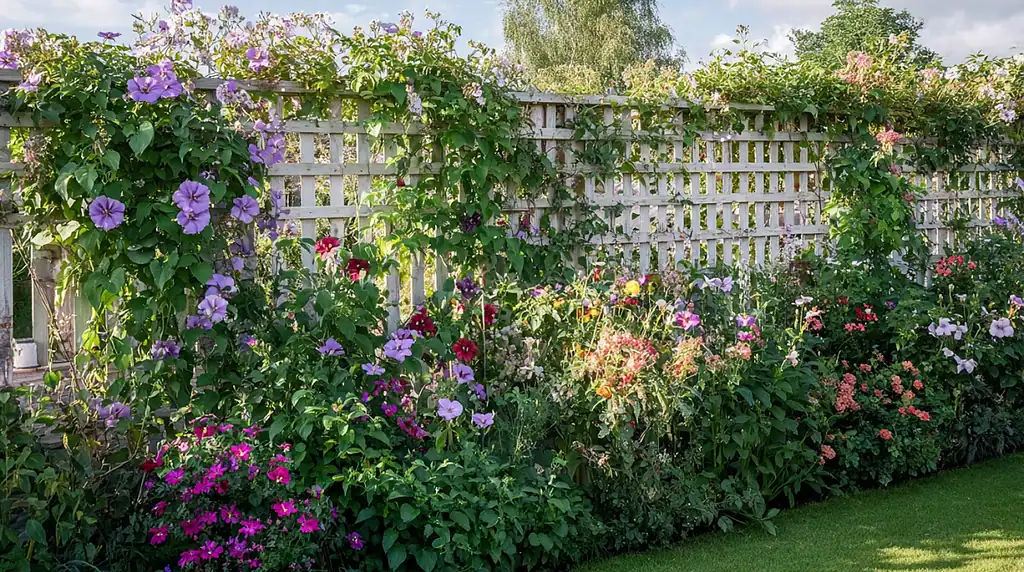
A trellis gives climbing plants a place to grow vertically, adding height and color to a plain fence.
This method is perfect for narrow spaces where ground planting space is limited, and it can even be adapted into simple trellises for privacy if you’d like more coverage from neighbors.
Plants like clematis, climbing roses, morning glory, jasmine, or sweet peas thrive on trellises and bloom at various times during the year.
A trellis also prevents vines from attaching directly to the fence, which helps protect wood or vinyl from moisture damage.
You can install individual panels at intervals or run a continuous trellis along the entire fence. This type of edging draws the eye upward and helps create a lush, layered backdrop.
5. Ground Cover Plants

Ground covers are low-growing plants that spread out and form a dense mat, making them perfect for the base of a fence.
Options like creeping thyme, ajuga, sedum, or sweet woodruff thrive in different light conditions and soil types. These plants help suppress weeds, retain moisture, and reduce soil erosion near the fence.
Some varieties also offer seasonal flowers, adding subtle color and fragrance. Ground covers are ideal for creating a soft, natural transition between the lawn and the fence line.
They require little maintenance once established and can even handle some foot traffic in more informal garden areas.
If you’re looking for inspiration, check out our guide to the best ground cover plants.
6. Edible Garden Border

Turning the space along your fence into an edible garden makes it both useful and appealing. You can plant herbs like basil, rosemary, thyme, or mint in rows or containers for easy access.
If you have more space, consider adding leafy greens, strawberries, or compact vegetable varieties like cherry tomatoes or bush beans.
Raised beds or trough planters work well if your soil isn't ideal or you want better drainage and control.
This setup lets you make the most of limited garden space while adding greenery and texture along the fence line. Plus, it keeps fresh ingredients just steps away from the kitchen.
7. Succulent Strip
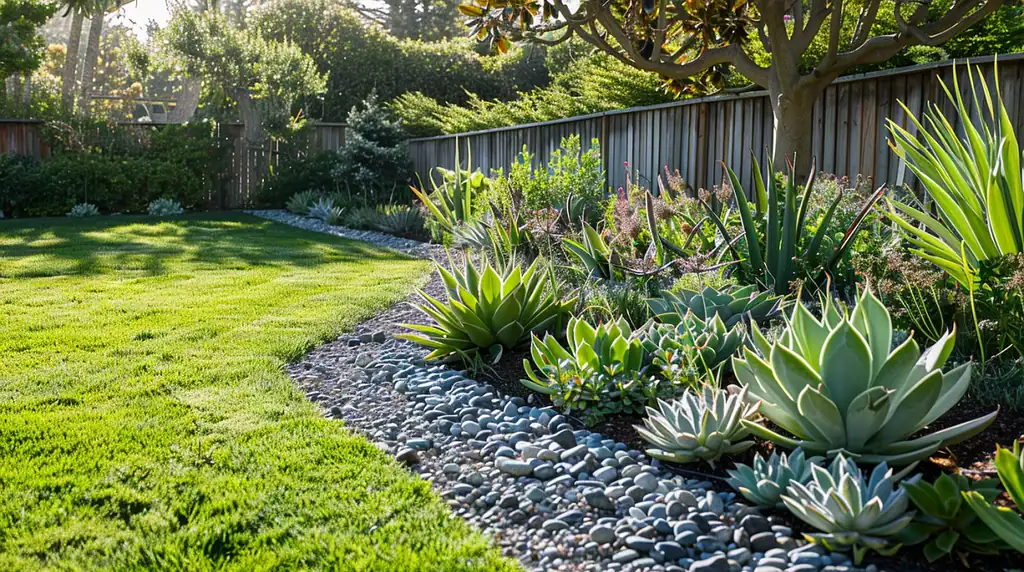
If your fence faces full sun and you want a low-maintenance option, a strip of succulents is a smart choice.
Plants like sedum, echeveria, agave, and hens-and-chicks thrive in hot, dry conditions and require minimal watering.
You can plant them directly in the ground, use a gravel bed for better drainage, or arrange them in decorative containers.
Their sculptural shapes and muted colors add visual interest without crowding the space.
Succulents also pair well with rock or stone edging, which helps define the area and keeps the planting zone tidy.
8. Narrow Evergreen Trees
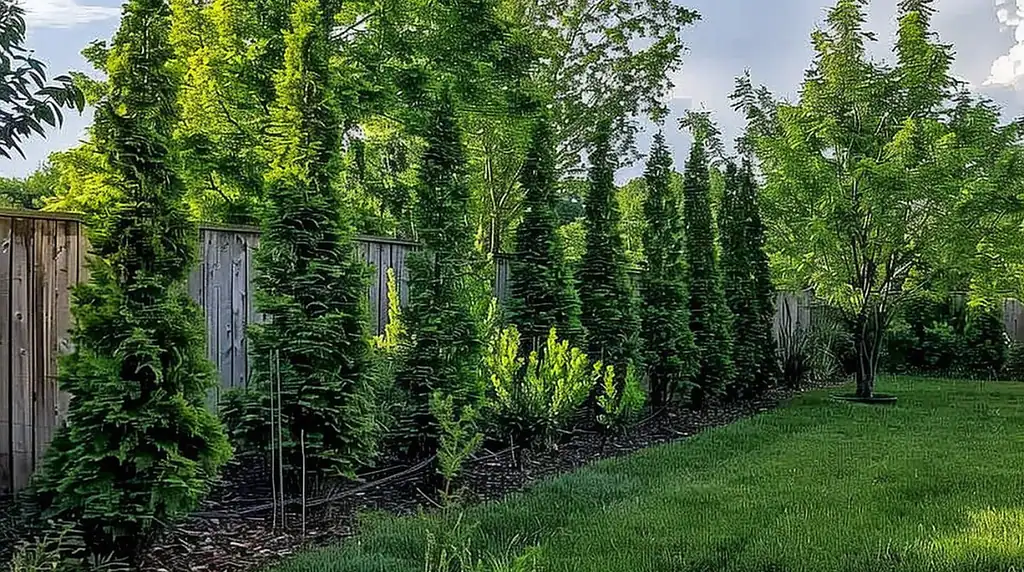
Tall, slim trees planted along a fence can provide year-round greenery and added privacy.
Varieties like Italian cypress, Sky Pencil holly, or emerald green arborvitae grow upright without spreading wide, making them suitable for tight spaces.
These trees act as a vertical backdrop that softens the fence and blocks views from neighbors or the street. When planting, be sure to space them according to their mature size to avoid overcrowding.
Also, leave enough distance from the fence for airflow and maintenance. This type of edging is especially useful for long, exposed fence lines.
9. Stone or Pebble Edging
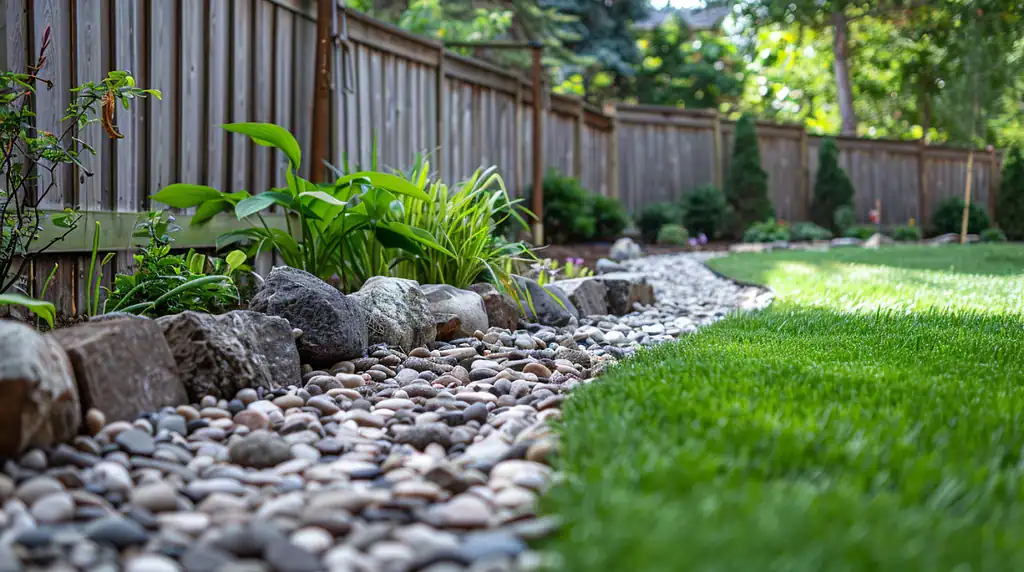
A border of stone or pebbles along your fence creates a clean, structured edge that works well with both modern and natural landscapes.
Use river rock, crushed granite, or mixed pebbles depending on the look you want. This type of edging helps with drainage and keeps mud or mulch from splashing onto the fence during rain.
It also makes mowing easier, as it forms a buffer between the grass and the fence.
Stone is long-lasting and doesn’t require much upkeep, making it a good choice if you want something permanent and low-effort.
10. Mulch Bed
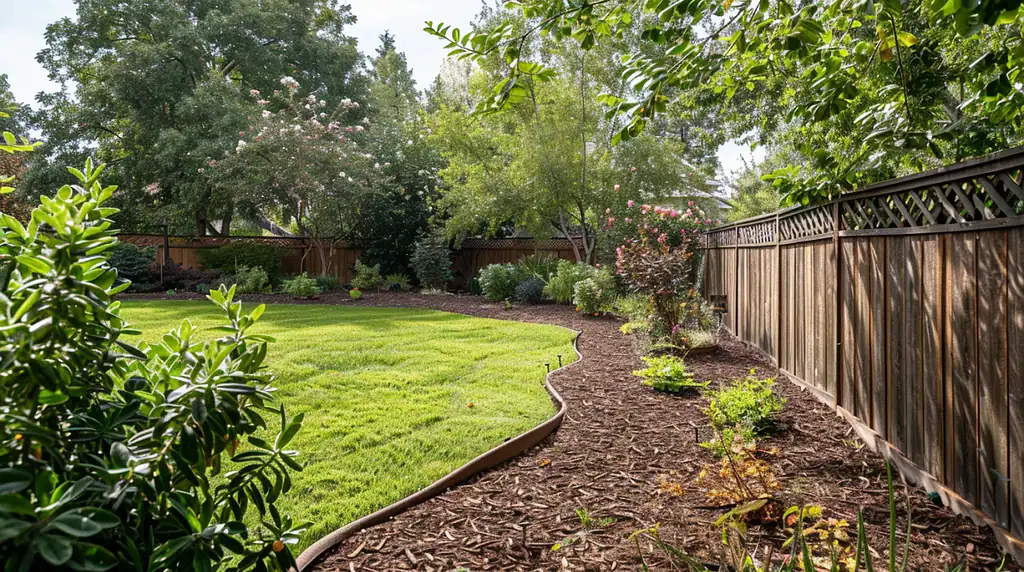
Spreading mulch along the fence line is a simple and effective way to define the space.
Organic mulch like wood chips, bark, or shredded leaves improves soil health, holds moisture, and reduces weed growth.
You can use a straight edge or create curved lines to shape the border, depending on your garden layout.
Mulch beds can be left bare for a clean, minimal look or combined with small plants for added interest. This method is budget-friendly and easy to update or expand later.
If you want more ideas to make your garden look its best, these useful garden mulch ideas are worth exploring.
11. Brick or Paver Edging

Using bricks or pavers to line the base of your fence creates a neat, finished look. You can lay them flat for a simple edge or stand them upright in a pattern for a more decorative border.
This type of edging works well in both formal gardens and rustic spaces, depending on the color and finish of the materials you choose.
Bricks and pavers are durable, weather-resistant, and easy to maintain.
They also act as a barrier between the lawn and planting beds, helping keep mulch, soil, and plants in place while making mowing and trimming easier.
Want more ideas that stand the test of time? Check out these timeless brick garden landscaping ideas.
12. Terracotta Pots as Borders
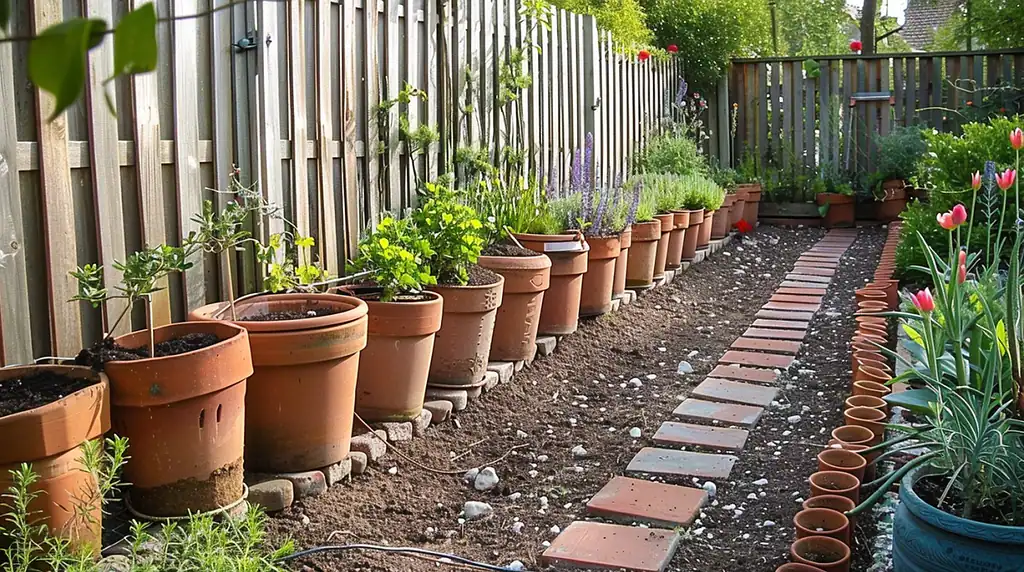
Terracotta pots placed in a row along the fence bring warmth and charm to the space. You can fill them with herbs, flowers, or trailing plants like ivy and lobelia.
Alternatively, use empty pots or broken terracotta pieces as a decorative edge. This method is especially useful if your soil conditions aren’t ideal for direct planting.
Pots also give you the flexibility to change the look seasonally by swapping out plants.
Grouping pots in sets of different sizes can add visual variety while keeping the fence line well-defined and easy to maintain.
13. Solar Lighting
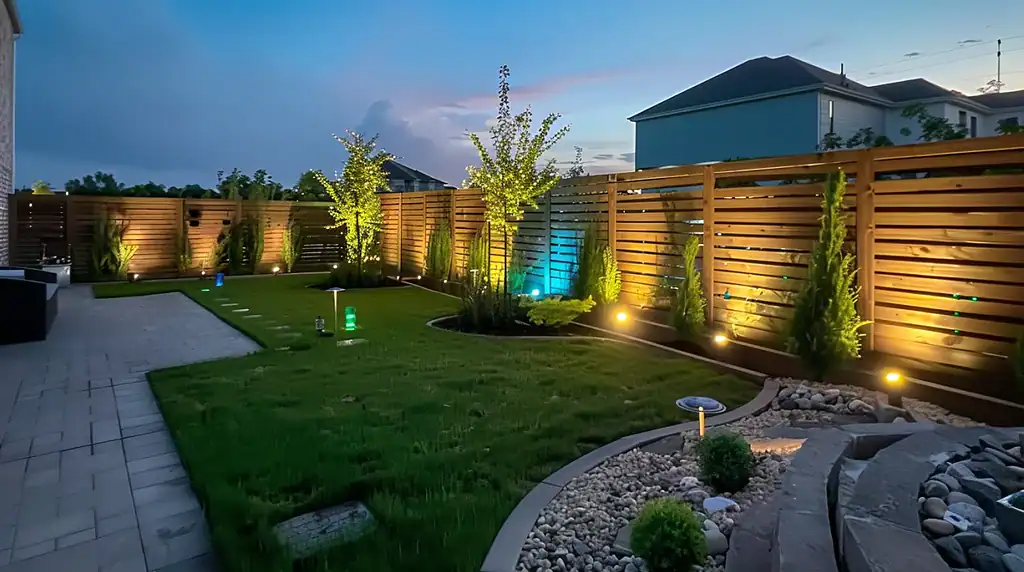
Adding solar lights to your fence edging serves both decorative and practical purposes.
You can install stake lights along the ground, string lights across the fence panels, or mount small fixtures directly onto posts.
Lighting highlights the edging features at night and improves visibility in dark corners. It's especially useful for paths or sitting areas near the fence.
Most solar options require no wiring and are easy to install. Choose warm white tones for a softer effect or cool white if you prefer a brighter, more modern look.
14. Hanging Planters or Baskets
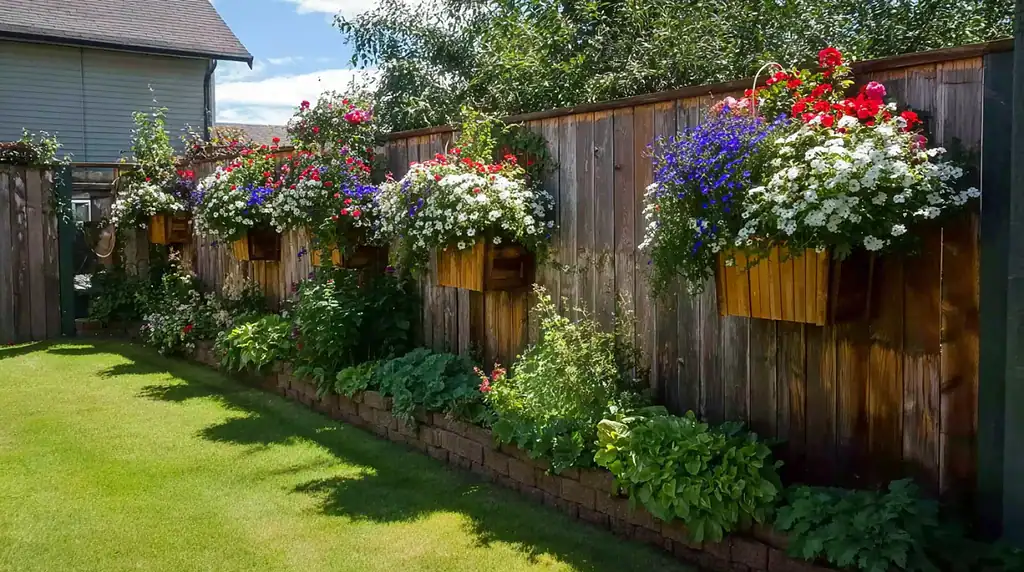
Hanging planters or wall-mounted baskets add vertical interest without taking up ground space. You can attach them directly to the fence or hang them from hooks or brackets.
Fill them with seasonal flowers, ferns, trailing vines, or even small edibles like strawberries and lettuce.
This method works well for narrow garden beds or areas where you want to add color without altering the soil.
Rotate plants by season to keep the display fresh, and use matching containers for a unified look or mix styles for a more relaxed setting.
15. Wooden Planter Boxes or Benches
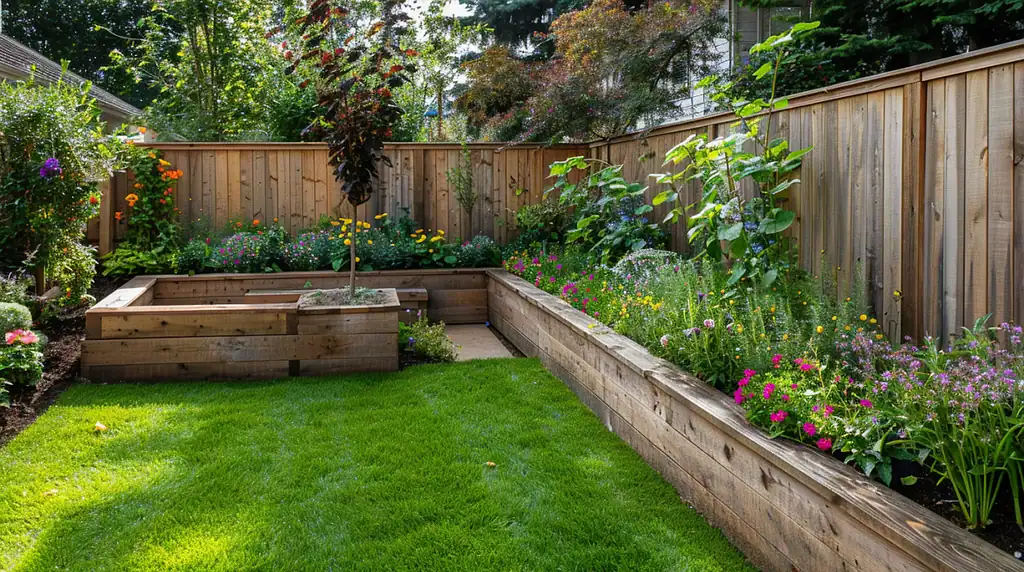
Built-in wooden features along your fence (like planter boxes or bench seating) add structure and function.
Planter boxes provide space for flowers, herbs, or shrubs, while benches create a spot to sit and enjoy the garden. You can stain or paint the wood to match the fence for a seamless appearance.
These elements are especially useful in small yards where every inch counts, as they combine storage, planting, and seating in one compact area.
They also break up long fence lines, making the space feel more inviting and intentional.
Looking for inspiration? These best DIY planters make it easy to add style and function to your fence.
Things to Consider When Planning Fence Edging
Before installing any type of fence edging, it’s important to plan based on your space, climate, and long-term goals.
Here are the key factors to keep in mind:
Sun and Shade Conditions
Check how much sunlight the area along your fence gets throughout the day. South-facing fences typically receive full sun, while north-facing ones often remain in shade.
Choose plants or materials that match those conditions.
For example, sun-loving plants like sedum or rosemary won’t thrive in shady spots, and shade-tolerant plants like hostas or ferns won’t do well in full sun.
Soil Type and Drainage
Some plants need well-draining soil, while others can tolerate more moisture. Before planting, assess the soil’s texture and how quickly water drains after rain.
If drainage is poor, consider using raised beds, gravel, or containers to avoid root rot. When using hardscape materials like stone or brick, make sure they don’t trap water against the base of the fence.
Fence Material Compatibility
Wood fences can rot or discolor if they stay damp for too long. Avoid placing wet mulch or dense plantings directly against wood panels.
With metal fences, watch for rust if water collects at the base.
Vinyl fences are more tolerant but can stain if soil or mulch regularly splashes up. Leave a gap between the fence and edging elements to allow airflow and maintenance access.
Maintenance and Time Commitment
Some edging options, like ornamental grasses or stone borders, require minimal care. Others, like flower beds or edible gardens, need regular attention.
Be realistic about how much time you can commit to watering, pruning, and seasonal changes.
Starting with low-maintenance edging and expanding over time can help keep the project manageable.
Spacing and Root Systems
Avoid planting too close to the fence, especially with trees or shrubs that have aggressive roots. Over time, roots can push against fence posts or cause damage below the surface.
Leave enough space for mature growth and for maintenance tasks like trimming, staining, or repairs.
Start Enhancing Your Fence Line With the Right Edging
Edging your fence doesn’t need to be complicated or expensive.
With the right combination of plants, materials, and layout, you can create a clean, finished look that ties your entire outdoor space together.
Whether you're aiming for more privacy, better structure, or just something that looks good year-round, there’s an idea on this list that will work in your space.
Before you get started, take a walk along your fence and assess what areas need the most attention.
Look at the sunlight, the soil, and how the edging might fit into your overall garden layout. Then, choose one idea from this list that fits your needs and try it out.
Have you added edging to your fence? What worked well for you? Comment down below – we’d love to hear your favorite ideas and experiences.
FAQs
1. What’s the best fence edging for rental properties or temporary setups?
If you need something temporary or non-permanent, try using freestanding planters, container gardens, or portable edging panels. These options don’t require digging or altering the fence and can be moved or removed easily.
2. How do I edge a fence if I have pets that dig or chew?
Choose durable materials like stone, brick, or metal edging to discourage digging. Avoid toxic plants, and leave enough open space for pets to move comfortably. For chewers, stay away from wood edging that could splinter or be treated with chemicals.
3. What’s the best way to keep weeds from growing along the fence line?
Use landscape fabric under mulch or stones to block weed growth. Ground cover plants that form dense mats, like ajuga or creeping thyme, are also effective at shading out weeds naturally.
4. Can I use fence edging to help with drainage or runoff problems?
Yes, edging with gravel, river rock, or shallow trenches can help redirect water away from the fence. Combine with slightly sloped grading to improve water flow and prevent pooling or erosion along the base.
5. How can I safely edge near a fence that has underground utilities?
Before digging, always contact your local utility company to mark underground lines. For shallow installations or container-based edging, you won’t need to dig deeply, but it’s still best to confirm the safety of the area first.
Ready To Transform Your Garden?
Are you looking for the best way to layout your garden beds? Maybe you're feeling a bit stuck on how to make the most of your space?
We’ve got you covered! Check out our 101+ Garden Bed Layout Ideas for your next raised bed project. This guide is filled with creative and practical ideas that can help you design a garden that fits your style, whether you’re just starting out or have been gardening for years.
Get your copy today and get inspired to bring your gardening dreams to life.

